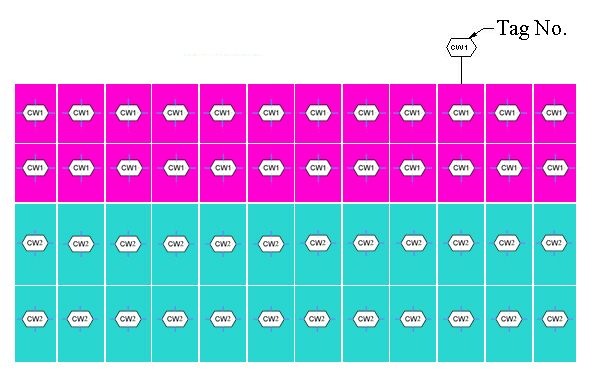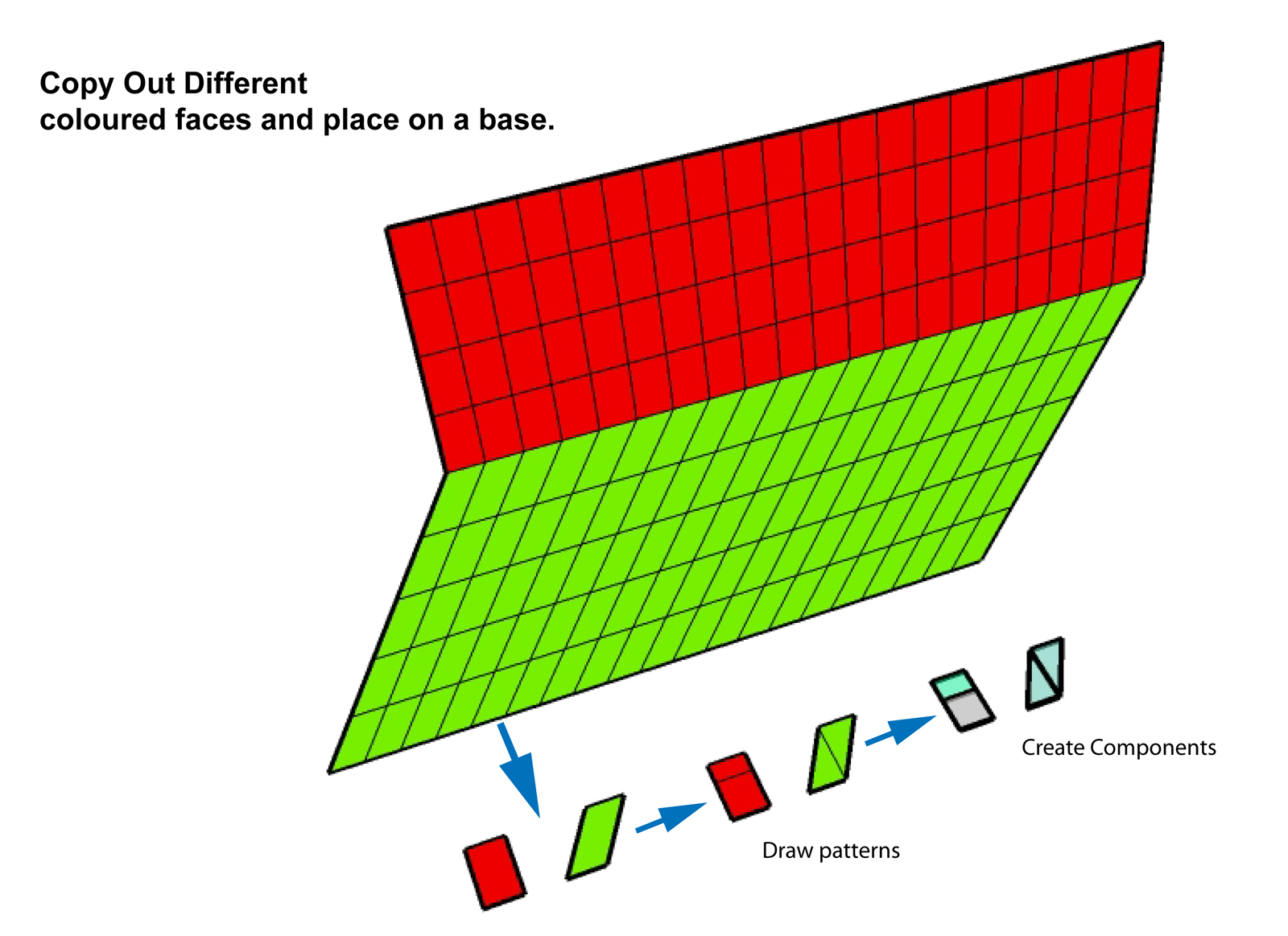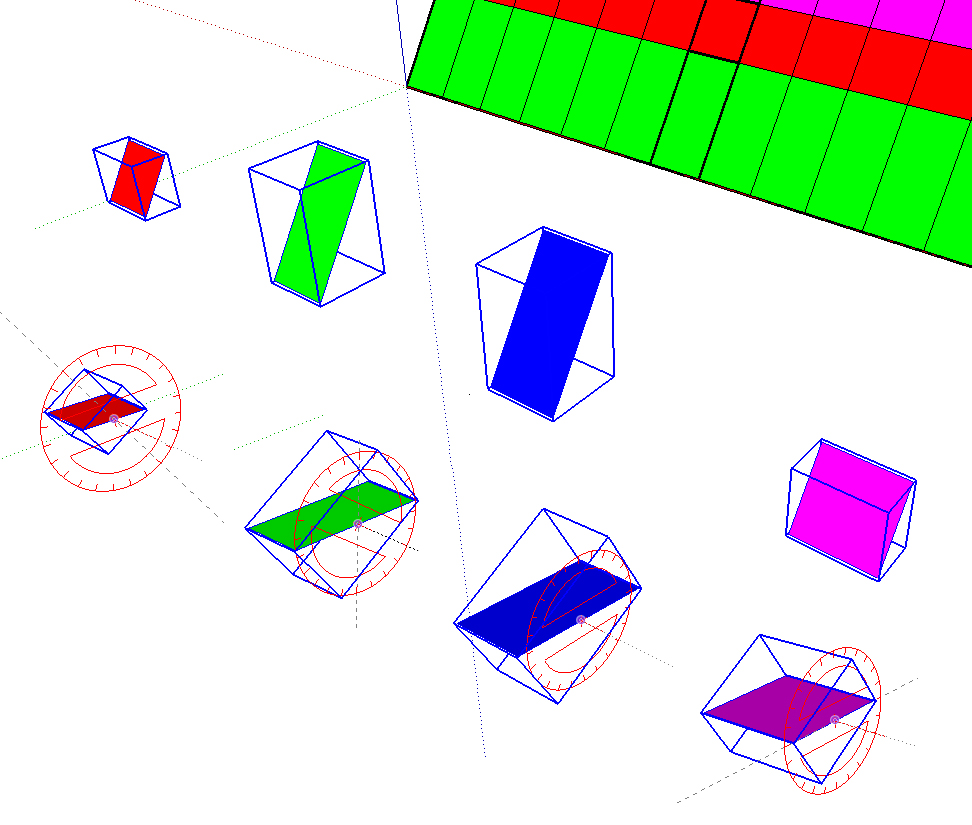Face-tag number
-
Hi,
I'm working on face-tag number of similar faces to tag the same number on normal faces and change colours to see the different panel types , could anyone give me some ideas how to do this method as you can see in a picture ? I'm not quite good at programming. I have to do this before doing component mapping on faces.

-
Here is an attempt to pick faces that have same area size and paint them. It is limited to up to five different area size for faces but you can modify it to add more. Not sure if this is the way to go but at least is a starting point and if I find better way I will share it. Also this does not add the tag object on top of face at the moment.
model = Sketchup.active_model @sel = model.selection ents = model.active_entities faces = ents.grep(Sketchup;;Face) @cw1 = [] @cw2 = [] @cw3 = [] @cw4 = [] @cw5 = [] faces.each do |face| ####### ## A ## ####### if @cw1.first == nil if face.area.to_i != @cw2area and face.area.to_i != @cw3area and face.area.to_i != @cw4area and face.area.to_i != @cw5area @cw1 << face @cw1area = face.area.to_i end end if @cw2.first == nil if face.area.to_i != @cw1area and face.area.to_i != @cw3area and face.area.to_i != @cw4area and face.area.to_i != @cw5area @cw2 << face @cw2area = face.area.to_i end end if @cw3.first == nil if face.area.to_i != @cw1area and face.area.to_i != @cw2area and face.area.to_i != @cw4area and face.area.to_i != @cw5area @cw3 << face @cw3area = face.area.to_i end end if @cw4.first == nil if face.area.to_i != @cw1area and face.area.to_i != @cw2area and face.area.to_i != @cw3area and face.area.to_i != @cw5area @cw4 << face @cw4area = face.area.to_i end end if @cw5.first == nil if face.area.to_i != @cw1area and face.area.to_i != @cw2area and face.area.to_i != @cw3area and face.area.to_i != @cw4area @cw5 << face @cw5area = face.area.to_i end end ####### ## B ## ####### model = Sketchup.active_model materials = model.materials if face.area.to_i == @cw1area @cw1 << face face.material = [255,0,0] end if face.area.to_i == @cw2area @cw2 << face face.material = [0,255,0] end if face.area.to_i == @cw3area @cw3 << face face.material = [0,0,255] end if face.area.to_i == @cw4area @cw4 << face face.material = [255,0,255] end if face.area.to_i == @cw5area @cw5 << face face.material = [255,255,0] end endIf you have any questions or suggestion please let me know...cheers!
-
@pingpink said:
I noticed the same face area of the sloped faces and the upright faces , they have different colours.I don't know why it happens for this time , I will look later.
Not sure myself why that is happening but will look into it.
@pingpink said:
I just tried to map components on coloured faces , but I have to select faces and a panel component together to place and copy on the faces.
Not sure that I have to do the attribute's name on coloured faces to have the same names as component's names for component mapping.To avoid having to select coponents and faces manually maybe try adding the code below to the one on top. Note that you have to name the component definition name manually.
components = ents.grep(Sketchup;;ComponentInstance) ######### ## cw1 ## ######### components.each do |component| if component.definition.name == "cw1" @sel.add component end end @sel.add @cw1 ##################################################### ## Put code that place component copy to face here ## ##################################################### @sel.clear #Clears selection to select cw2 ######### ## cw2 ## ######### components.each do |component| if component.definition.name == "cw2" @sel.add component end end @sel.add @cw2 ##################################################### ## Put code that place component copy to face here ## ##################################################### @sel.clear ######### ## cw3 ## ######### components.each do |component| if component.definition.name == "cw3" @sel.add component end end @sel.add @cw3 ##################################################### ## Put code that place component copy to face here ## ##################################################### @sel.clear ######### ## cw4 ## ######### components.each do |component| if component.definition.name == "cw4" @sel.add component end end @sel.add @cw4 ##################################################### ## Put code that place component copy to face here ## ##################################################### @sel.clear ######### ## cw5 ## ######### components.each do |component| if component.definition.name == "cw5" @sel.add component end end @sel.add @cw5 ##################################################### ## Put code that place component copy to face here ## #####################################################Hope this helps and your plugin look very good from the video I saw...very impressive!

-
Thank you kindly for your recommendation , it's my task to do facade modeling. I'm revising codes in each module now to make it better.
I'm curious that Is there a way to do a code for copying different coloured panels and lay down on a base in the program ? For example , in a picture there are 2 different panels and I want to copy out. So, it can reduce a time of copying faces to draw patterns and convert to components, and then do mapping prototype panels back onto faces.

-
Hi, here is one example on how to do what you mentioned. Add the following code bellow the one on top...
@model = Sketchup.active_model @sel = @model.selection @ents = @model.active_entities ### if @cw1.first != nil @sel.clear cw1sample = @cw1.first @sel.add cw1sample cw1group = @ents.add_group(@sel) tr1 = Geom;;Transformation.new([0, -300, 0]) instance = @ents.add_instance(cw1group.definition, tr1) instance.transform!(tr1) end ### if @cw2.first != nil @sel.clear cw2sample = @cw2.first @sel.add cw2sample cw2group = @ents.add_group(@sel) tr1 = Geom;;Transformation.new([200, -300, 0]) instance = @ents.add_instance(cw2group.definition, tr1) instance.transform!(tr1) end ### if @cw3.first != nil @sel.clear cw3sample = @cw3.first @sel.add cw3sample cw3group = @ents.add_group(@sel) tr1 = Geom;;Transformation.new([400, -300, 0]) instance = @ents.add_instance(cw3group.definition, tr1) instance.transform!(tr1) end ### if @cw4.first != nil @sel.clear cw4sample = @cw4.first @sel.add cw4sample cw4group = @ents.add_group(@sel) tr1 = Geom;;Transformation.new([600, -300, 0]) instance = @ents.add_instance(cw4group.definition, tr1) instance.transform!(tr1) end ### if @cw5.first != nil @sel.clear cw5sample = @cw5.first @sel.add cw5sample cw5group = @ents.add_group(@sel) tr1 = Geom;;Transformation.new([800, -300, 0]) instance = @ents.add_instance(cw5group.definition, tr1) instance.transform!(tr1) endI had to make face that you want to copy & move a group so at the end they are still groups. Not sure if you want to explode them back to lose face but I am sure there is a way to do that. Anyways hope this help...cheers!
-
Thank you so much ! , The code is amazing to copy tag faces. The group result suits with my code to convert groups to components and create the center axis on the panel plane , but my code can do mapping components on faces only the component which is parallel to the floor, not vertical exactly copy from the model. So , I tried to rotate panels by this code :
#tr1 = Geom;;Transformation.new([0, -300, 0]) pt = [300,0,0] v = Geom;;Vector3d.new(1,0,0) # The axis position to rotate opanel tr1 = Geom;;Transformation.rotation(pt,v,-45.degrees) instance = @ents.add_instance(cw1group.definition, tr1) instance.transform!(tr1)The code cannot be used properly if there is a slope panel group . The outcome of rotation could not be flat plane rotation. In the image , the rotation have to be like this , so the components can be placed fit onto the subdividing faces. Ah,I just found the example of rotation in this link. I think it works : [http://sketchucation.com/forums/viewtopic.php?f=15&t=41419](http://sketchucation.com/forums/viewtopic.php?f=15&t=41419)Thanks once again for good advice.

-
Hi, this might be the way to get them all flat...
@model = Sketchup.active_model @sel = @model.selection @ents = @model.active_entities ### if @cw1.first != nil @sel.clear cw1sample = @cw1.first @sel.add cw1sample faces = @sel.grep(Sketchup;;Face) faces.each do |face| PI = Math.acos(-1) @rot = Math;;acos(face.normal.z)*(180/PI) end cw1group = @ents.add_group(@sel) tr1 = Geom;;Transformation.rotation(ORIGIN, X_AXIS, -@rot.degrees) tr2 = Geom;;Transformation.new([0, -300, 0]) instance = @ents.add_instance(cw1group.definition, tr1) instance = instance.transform!(tr2) end ### if @cw2.first != nil @sel.clear cw2sample = @cw2.first @sel.add cw2sample faces = @sel.grep(Sketchup;;Face) faces.each do |face| PI = Math.acos(-1) @rot = Math;;acos(face.normal.z)*(180/PI) end cw2group = @ents.add_group(@sel) tr1 = Geom;;Transformation.rotation(ORIGIN, X_AXIS, -@rot.degrees) tr2 = Geom;;Transformation.new([200, -300, 0]) instance = @ents.add_instance(cw2group.definition, tr1) instance = instance.transform!(tr2) end ### if @cw3.first != nil @sel.clear cw3sample = @cw3.first @sel.add cw3sample faces = @sel.grep(Sketchup;;Face) faces.each do |face| PI = Math.acos(-1) @rot = Math;;acos(face.normal.z)*(180/PI) end cw3group = @ents.add_group(@sel) tr1 = Geom;;Transformation.rotation(ORIGIN, X_AXIS, -@rot.degrees) tr2 = Geom;;Transformation.new([400, -300, 0]) instance = @ents.add_instance(cw3group.definition, tr1) instance = instance.transform!(tr2) end ### if @cw4.first != nil @sel.clear cw4sample = @cw4.first @sel.add cw4sample faces = @sel.grep(Sketchup;;Face) faces.each do |face| PI = Math.acos(-1) @rot = Math;;acos(face.normal.z)*(180/PI) end cw4group = @ents.add_group(@sel) tr1 = Geom;;Transformation.rotation(ORIGIN, X_AXIS, -@rot.degrees) tr2 = Geom;;Transformation.new([600, -300, 0]) instance = @ents.add_instance(cw4group.definition, tr1) instance = instance.transform!(tr2) end ### if @cw5.first != nil @sel.clear cw5sample = @cw5.first @sel.add cw5sample faces = @sel.grep(Sketchup;;Face) faces.each do |face| PI = Math.acos(-1) @rot = Math;;acos(face.normal.z)*(180/PI) end cw5group = @ents.add_group(@sel) tr1 = Geom;;Transformation.rotation(ORIGIN, X_AXIS, -@rot.degrees) tr2 = Geom;;Transformation.new([800, -300, 0]) instance = @ents.add_instance(cw5group.definition, tr1) instance = instance.transform!(tr2) endHope this is what you were looking for...cheers!
-
Thank you very very much Renderiza !
After running a code , there's an error about the constant's name of " PI "PI = Math.acos(-1)So , I changed it to be
pi = Math.acos(-1)And it works perfectly to copy out the different panel types !
I'm wondering again , in case of " RE-TAG NO." of face to change a new name and
a new colour. I defined the variables to relate with the function of copyout_rotate2.rb@cw6 = [] @cw7 = [] @cw8 = [] @cw9 = [] @cw10 = []But there's a SyntaxError in this part of condition between 'and'...
Not sure if there's a limitation of values. My intention is to do a copy flat panel at the end result after finished tagging panels , but in some cases of same area panel would have different patterns or materials , so they should have different names , and colours to replace the correct panel components.if @cw1.first == nil if face.area.to_i != @cw2area and face.area.to_i != @cw3area and face.area.to_i != @cw4area and face.area.to_i != @cw5area and face.area.to_i != @cw6area and face.area.to_i != @cw7area and face.area.to_i != @cw8area and face.area.to_i != @cw9area and face.area.to_i != @cw10area @cw1 << face @cw1area = face.area.to_i end end


-
But then again...
Math::PI
gives you PI without the convolution,
as does
180.degreesI don't understand the unneeded complexity...
-
Pi is part of the Math module:
Math::PIAlso, beware that there is an important difference between
andand&&as well asorand||. https://www.tinfoilsecurity.com/blog/ruby-demystified-and-vs -
Thanks TIG , tt_su
pi = Math::PI is Math.acos(-1) ? It has a same result after testing a code. I read in the link , thinking that it should be put in a pair at the same line. There's no errors.It works!if @cw1.first == nil if face.area.to_i != @cw2area and face.area.to_i != @cw3area and face.area.to_i != @cw4area and face.area.to_i != @cw5area and face.area.to_i != @cw6area and face.area.to_i != @cw7area and face.area.to_i != @cw8area and face.area.to_i != @cw9area and face.area.to_i != @cw10area @cw1 << face @cw1area = face.area.to_i end endBUT , it my RE_TagNo.rb seems doesnt't link with the copyout_rotate2_and.rb to bring out the re-tag face panel.###### ADDING faces = sel.grep(Sketchup;;Face) @cw6 = [] @cw7 = [] @cw8 = [] @cw9 = [] @cw10 = [] faces.each do |face| if @cw6.first == nil @cw6area = face.area.to_i elsif @cw7.first == nil @cw7area = face.area.to_i elsif @cw8.first == nil @cw8area = face.area.to_i elsif @cw9.first == nil @cw9area = face.area.to_i else @cw10.first == nil @cw10area = face.area.to_i end endif input[1] == "Orange" #attribute_name = input[0].name #face.area.to_i == @cw6area faces.each do |e| e.material = [255,165,0]#Orange end
-
Thank you very much,Renderiza !
I've tested the codes , it works very good.I can see the different panel types by coloured faces. I noticed the same face area of the sloped faces and the upright faces , they have different colours.I don't know why it happens for this time , I will look later. I just tried to map components on coloured faces , but I have to select faces and a panel component together to place and copy on the faces. Not sure that I have to do the attribute's name on coloured faces to have the same names as component's names for component mapping.
Advertisement







